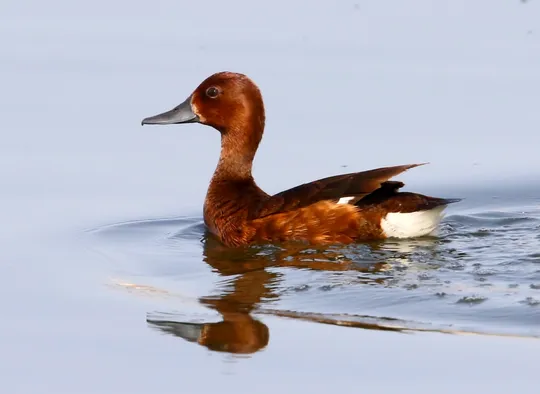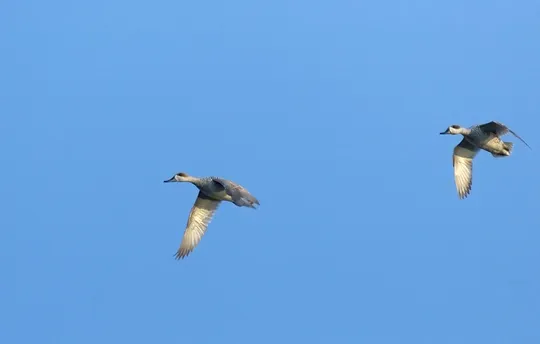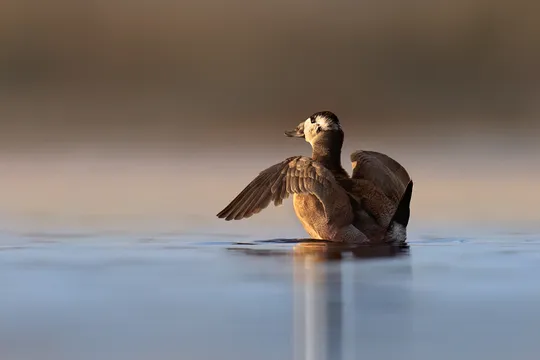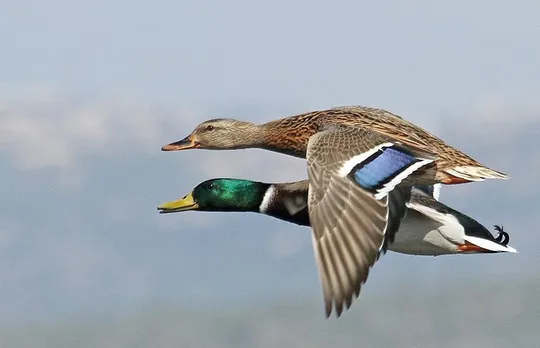Aythya nyroca
 Endangered
Endangered

| Habitats | Wetland Thickets |
|---|---|
| Presence In Israel | Summer, Winter Visitor, Migrant |
| Breeding In Israel | Breeder |
| Migration Types | Resident, Nomad |
| Zoographical Zones | Mediterranean, Sudani |
| Landscape Types | Wetlands, Fresh Water, Wetland Thickets |
| Vegetation Densities | Medium |
| Nest Locations | Ground, Wetland Thickets |
| Diet Types | Invertebrate, Herbivore |
| Foraging Grounds | Water |
| Body Sizes | Medium (500 - 1000g) |
| Threat Factors | Wetland Drainage & Pollution |
The Ferruginous Duck is a rare breeder in reservoirs in the Judean Lowlands and in the reservoirs and sinkholes in the Dead Sea area, and a relatively rare passage migrant and wintering species in water bodies throughout Israel. Until the mid-20th century, it was a relatively common breeder (tens and possibly hundreds of pairs) in northern Israel, particularly in the Hula Valley. The species stopped nesting in northern Israel after the Hula Marshes and other wetlands in northern Israel were drained. In the 1970s, it was discovered nesting once again, in small numbers and not every year. The summering population comprised 100-200 birds in the 1980s, most of them in the Hula Valley and the Northern Valleys, but also on the Carmel coast and the Tel Aviv Metropolitan area (Paz 1986, Shirihai 1996).
Marshes and freshwater bodies surrounded by vegetation thickets.
The main reason for the decline of the Ferruginous Duck population is the loss and degradation of suitable nesting habitats – water bodies with well-developed bank vegetation. In addition, uncontrolled hunting affects the species on a global level and to a lesser degree in Israel as well. Plans to renovate water reservoirs in the Judean Lowlands and to seal them with polyethylene sheeting threatens the future of the species in Israel.
Conservation and rehabilitation efforts of Ferruginous Ducks include a breeding nucleus (in the Jerusalem Biblical Zoo) and releasing young into nature. The project has been ongoing since 2015, but there is still no evidence regarding the reintroduction and integration success of released ducks in the wild breeding population.
The Ferruginous Duck is an endangered species in Israel and globally threatened due to the overexploitation and deterioration of wetlands. Its population in Israel is very small, although in recent decades there is an increase in the breeding population and expansion of the species in the Judean Lowlands and the Dead Sea depression. The future of the species in Israel is dependent on the existence of reservoirs and pools with dense bank vegetation.
The Ferruginous Duck breeds in water pools and reservoirs with dense bank vegetation, therefore it is recommended to allow vegetation thickets to develop around water bodies. In addition, the species is very sensitive to lead residues in and around water bodies (Slobodian et al. 2015), therefore use of lead shot for hunting should be banned.
- פז, ע. 1986. עופות. מתוך אלון, ע. (עורך), החי והצומח של ארץ ישראל. כרך 6. הוצאת משרד הביטחון, ישראל.
- פרלמן, י. 2013. ברווזים נדירים דוגרים בישראל סיכום ניטור קיץ 2013. דו"ח רשות הטבע והגנים והחברה להגנת הטבע.
- פרלמן, י. וחביב, א. 2014. ברווזים נדירים דוגרים בישראל סיכום ניטור קיץ 2014. דו"ח רשות הטבע והגנים והחברה להגנת הטבע.
- Shirihai, H., 1996. The Birds of Israel. Academic Press, London.
- Slobodian, L., Lewis, M. & Lehmann, C. 2015 (2nd edition). Guidelines on National Legislation for the Protection of Species of Migratory Waterbirds and their Habitats. AEWA Conservation Guidelines No. XX, AEWA Technical Series No. XX, Bonn, Germany.
- Symes, A. 2013. Species generation lengths. Unpublished, BirdLife International.
- Species page at Birdlife International
Current Occupancy Map
| Data Missing | Sporadic | Limited Sites | Low Density | High Density |
|---|---|---|---|---|
| 0 | 0 | 0 | 0 | 0 |
Distribution maps
The maps presented here provide visual information on the distribution of species in Israel from the past and present, and the changes in occupancy and breeding density during the comparison period. For further reading
Relative Abundance 2010-2020
Breeding density values in the current decade as determined from experts' opinion and observations from databases.
| Data Missing | Sporadic | Limited Sites | Low Density | High Density |
|---|---|---|---|---|
| 8 | 12 | 12 | 21 | 19 |
Relative Abundance 1980-1990
Density values based primarily on the book The Birds of Israel (Shirihai 1996).
| Data Missing | Sporadic | Limited Sites | Low Density | High Density |
|---|---|---|---|---|
| 5 | 14 | 14 | 17 | 22 |
Occupancy 1990-2020
The map shows differences in the species breeding distribution between the 1980's breeding map and the current weighted breeding evaluation. Negative value - species previously bred in the grid and is not presently breeding; positive value - species has not previously bred in the grid and is currently breeding.
| Data Missing | No Change | Occupancy Increase | Occupancy Decrease |
|---|---|---|---|
| 6 | 35 | 1 | 9 |
Change in Relative Abundance 1990-2020
The map shows the changes in the relative abundance of a species in each of the distribution grids between the breeding map of the 1980s and the weighted current breeding evaluation. Negative values - decline in abundance; positive values - increase in abundance; zero - no change in abundance.
| 80 to 100 | 50 | 20 to 30 | No Change | 30- to 20- | 50- | 100- to 80- | Data Missing |
|---|---|---|---|---|---|---|---|
| 0 | 4 | 2 | 22 | 12 | 14 | 11 | 16 |
| Rarity | |
|---|---|
| Vulnerability | |
| Attractiveness | |
| Endemism | |
| Red number | |
| Peripherality | |
| IUCN category | |
| Threat Definition according to the red book |
 Contributed:
Contributed: 





